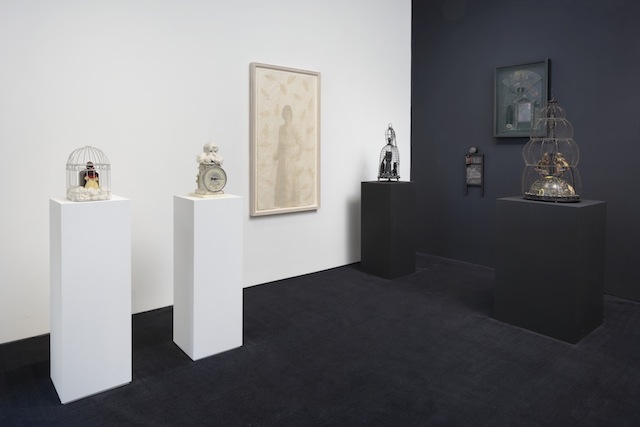Roberts & Tilton, Los Angeles 10 September – 17 December 2016
Betye Saar’s double exhibition at Roberts & Tilton coincides with the opening of her career survey at the Fondazione Prada, Milan. The first exhibition, titled Black White (which opened a month before the second exhibition), is a more concise presentation in the gallery’s project space that arranges assemblage sculptures and collages spanning from the present back to an early etching by the artist – now a nonagenarian – from 1964. Blend, the second and more generously spaced display (actually including fewer works), occupies the main gallery. Its focus is the major mixed media installation Mojotech (1987), which stretches nearly 7.5 metres along one wall and was the outcome of a residency Saar undertook at the List Visual Arts Center at the Massachusetts Institute of Technology (MIT), in Cambridge.
The loose conceit for this exhibition, reflected in the separate titles, is that Black White not only organises the broadly monochromatic works according to their colour, but also reflects critically on how specific meanings attach to colours and symbols. Blend, according to the exhibition handout, is the more ‘ambiguous, arbitrary and abstract’ of the two. The reality is that there are works in each that could easily be shown in the other. A more productive observation is that, throughout her career, Saar has always moved back and forth between engineering explicit meanings and casting mysterious spells, between the political and the personally intuitive, and between – at the risk of sounding glib – ‘issues’ and ‘poetry’.
Mojotech is an apposite example in this regard. A wide ziggurat of wall-mounted panels, the work progresses symmetrically from its blue and black outer extents, with occult symbols painted over green circuit boards, inwards and upwards through blue then terracotta then white panels, with pieces of digital componentry fixed alongside mirrors, clocks, little skeleton figurines and pieces of animal bone. A perforated metal sheet is fringed with snakeskin. Above it, eyes stare out at us; below it hangs a heart. Reportedly, visitors to its 1987 installation at MIT brought offerings that they placed on an altarlike shelf, among candles and compact discs.
Saar professes to believe in certain forms of mysticism and arcana, but standing in front of Mojotech, it is hard to shake the idea that here she is using this occult paraphernalia to satirise the faith we place in the inscrutable workings of technology. Across the room, a throne bristles with wired-together metal leaves, keys, eyes, hearts and other trinkets, lit from beneath by a tube of blue neon. Pause Here – Spirit Chair (1996), which rests on black coal, is an object at once absurd and deeply serious. Many of the knickknacks look as if they were purchased from gift shops or garden centres. But placed centrally among the kitsch is a medallion commemorating Martin Luther King’s 1964 Nobel Peace Prize. Other symbols suddenly take on extra significance: an ornament depicting a sailing boat becomes a slave ship; those keys become instruments of incarceration. The chair is not so much the throne of a king but a homemade and heartfelt shrine to his memory.
Because Saar is an African-American artist who regularly appropriates derogatory racial imagery, her more subdued work is often overshadowed by its incendiary counterparts. In Black White, beside sculptures combining birdcages and cotton bolls, head-scarfed Mammies and black crows, a series of four framed collages from 1982 reveals Saar’s quiet side. One exquisite piece includes pencil drawings of birds, a tarot card and torn pieces of paper sewn on with threads dangling. Its title alludes to the narrowly glimpsed interior life of a publicly political artist: Every Secret Thing (Almost) (1982).
This article first appeared in the December 2016 issue of ArtReview
